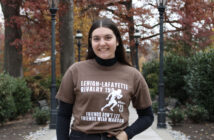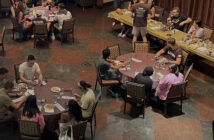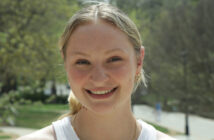An discussion held at the Women’s Center on Nov. 11 about the pro-ana, pro-mia and fat activism movement exchanged views on the popular and dangerous trend of poor eating habits.
The terms “pro-ana” and “pro-mia” refers to the promotion of anorexia and bulimia to achieve an ideal body image while “fat activism,” on the other hand, believes in accepting obese, over-weight and plus-sized body types.
The discussion was led by Carly Novek, ’15, an intern at the Women’s Center, who frequently leads discussions and harnesses her focus on body image in the media, in fashion and as a media outlet. This discussion in particular was focused on body image on websites such as Pinterest, as well as pro-ana blogs and forums.
Novek began the discussion by starting out with Pinterest, a website that uses images and text to discover different ideas for projects by creating different pages for different topics. Novek personally calls it a “how-to guide.” She displayed the page titled “pro-ana” to the room, which displayed scantily dressed adolescent women who looked unhealthily underweight. This is also known as “skinny imagery.” The next page that was shown was called “Thinspo”, which is short for “thinspiration.” These images however, also included text-images that show tips on how to be anorexic.
“They use a militant, radical and controlling voice; they’re words to live by to be anorexic,” Novek said.
One image labeled “Oh How the Boys Will Stare” shows that “you can only get these men or be successful this way if you look like this,” said Samantha Di Paolo, ’18.
Novek then shared a few anorexic blogs that serve as social places and are more difficult to find, she said from her personal inexperience researching the topic.
“Group-wise, this makes them feel more elitist,” Novek said.
One website in particular is called “Ana Boot Camp” which included over 50 rules on how to be anorexic. Some might even view these groups as a type of cult, according to Novek.
“People make it more a part of their lives than the disorder does,” she said in response to people who wear red bracelets to show that they are ‘pro-ana.’
When Novek displayed the fat activist or fat acceptance pages, the pages were more positive, using drawings and words, such as health tips, instead of imagery.
“For fat activists, we’re blaming the person for not being skinny enough, while for pro-ana we blame the disorder,”said Rita Jones, the Director of the Women’s Center. “We don’t’ realize that fat activists might not be diagnosed with a disorder but they do have internal struggles.”
The conversation took a different direction when Catheryn Llibre, ’15, was curious to find out how race and class contribute to the movement. The group agreed that the Pinterest pro-ana/mia pages feature mostly white women, which concluded that cultures do shape how we view body acceptance by the way we frame our language and by what is accepted.
“The term ‘fat’ is not equally acceptable to everyone,” Jones said.
One of the major issues regarding these websites that the group discussed was censorship. Most of these websites in fact shared one thing in common – a disclaimer to the websites. A link to the National Eating Disorder helpline rests at the top of the pro-ana/mia and Thinspo Pinterest pages.
“They can put these warnings up but can’t take the site down,” Novek said.
While there is easy access to view these pages, these groups want to be heard and have control over one of their internal struggles, according to Di Paolo.





Comment policy
Comments posted to The Brown and White website are reviewed by a moderator before being approved. Incendiary speech or harassing language, including comments targeted at individuals, may be deemed unacceptable and not published. Spam and other soliciting will also be declined.
The Brown and White also reserves the right to not publish entirely anonymous comments.